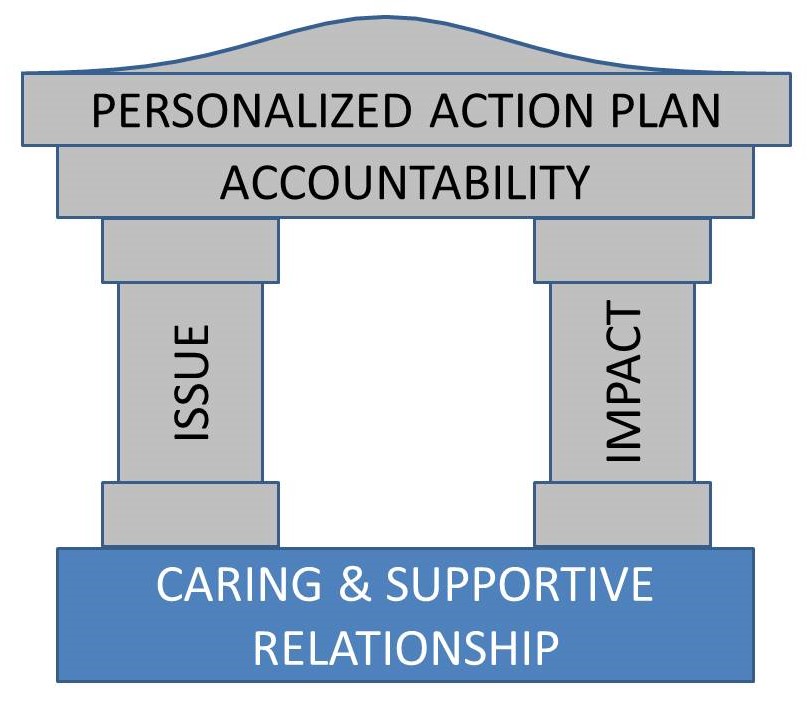A Model for Coaching
Published February 2018
Back when I was a management pup I was exposed to excellent coaching training. The instructor had an 8-part model to guide the coaching discussion. We learned the model and practiced it in role-playing simulations.
I was awed that a skill as seemingly nebulous as coaching could be simplified into a model. Over the years I used the model religiously, most often with success.
There was just one small problem … with eight components the model exceeded my (and my classmates’) memory capacity. Many of us posted the model in our offices, typically directly behind the seat where the employee being coached sat. This worked OK, unless coaching a tall employee.
So 25 years later as I began working with clients on coaching, I strived to develop a simpler, yet effective model.
Picture a “house” similar to the Lincoln Memorial consisting of five components:
- A horizontal rectangular foundation
- Two vertical rectangular pillars, one on each side of the foundation
- A roof, not a typical triangular profile but a normal distribution (bell) curve
- A horizontal rectangular ceiling, nestled between the top of the pillars and the roof

Our foundation for successful coaching is a “Caring and Supportive Relationship.” People are much more receptive to feedback when they know the input is coming from someone who has their best interests at heart. This means that, as supervisors, we need to be continuously working on that foundation. The antithesis of this is the employee who only hears “see me” from the boss when they are in trouble.
The foundation can be reinforced even during the actual coaching conversation by balancing the concern with things the employee does well, listening, empathizing, and owning up to our role in the situation if appropriate.
The left pillar is the “Issue” to be discussed. This could be a concern that needs to be nipped in the bud or a potential opportunity that we wish to persuade the employee to pursue.
If the issue is a problem, it’s best to discuss while small. I had verbal agreements with most of my employees allowing me to err on the side of over-reacting rather than waiting too long if there was a perceived problem.
Limit a coaching conversation to one issue. Cite observed behaviors (“Yesterday you snapped at Tim during our team meeting.”) rather than assumptions (“You’re trying to bully your teammates.”) to support your concern. Observations are less debatable.
Listen to the employee’s perspective; often you’ll learn something new. But confront excuses (“I realize that we’re all stressed with the project deadline looming, but that doesn’t permit us to disrespect each other.”).
The right pillar is the “Impact” of the issue. This provides the motivation for addressing the issue, the why behind the what. What are the positive consequences to the individual and the organization if they take advantage of the opportunity or address the problem? What may happen if they don’t?
It can be effective to ask open-ended questions to allow the employee to identify the impact (“How would our team function if we allowed that behavior to be commonplace?”). Don’t be afraid to use silence, allowing them time to think things through.
While emphasizing natural consequences is typically warranted, it’s important to clarify imposed consequences if persistence of the issue will lead to disciplinary action (“The next time I observe that it will result in a written warning.”).
The roof is a “Personalized Action Plan,” a collaborative improvement plan developed by the coach and the employee. It is uniquely designed for the employee taking into account the issue, their history and the degree to which they hold themselves accountable.
The roof’s bell curve profile reminds us that personal accountability varies from person to person, just like height, weight, IQ, etc. Our plan will be more detailed and with a shorter feedback loop when dealing with someone on the low end of the personal accountability scale. Treating someone with high personal accountability the same would be insulting.
Prior to leaving the conversation, we need to ensure that both parties are committed to the plan and are reasonably confident that it can be successful. Hesitation to either should be addressed immediately.
The discussion and plan must be documented. When dealing with someone with high personal accountability, chances are good that they have been taking notes. In any event, an agreed to documented summary is vital.
Finally, the ceiling is “Accountability.” An overarching environment must exist whereby we follow up on our plans. Positive results are recognized. Negative results trigger consequences already communicated during the coaching discussion.
The coaching discussion is the tool for developing employees which is the primary task for any supervisor. Skillfully accomplished, it reduces the number of subsequent difficult accountability discussions. More importantly, it dramatically increases the odds of a growing and engaged employee. That’s worth practicing and doing really well.
—
Back to the Working Great! archivesView the PDF version:
Check out the Working Great! archives for columns on other pertinent business issues
Copyright 2018 Brimeyer LLC. All Rights Reserved.